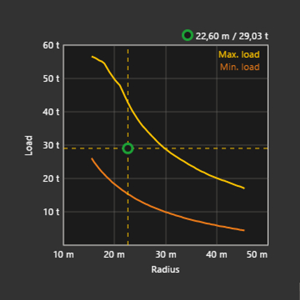
Start with the first lifting capacity data table and identify the radius and main boom length – in our example this is a 16m radius and a 37m main boom length. the total counterweight / ballast and whether it is fully rigged or half rigged. There are often numerous lifting capacity data tables based on the cranes setup – e.g. Now you have the checked that the radius can be achieved and you know the required boom length, you must turn to the corresponding lifting capacities data table – usually the previous or the following page in the crane specification. Finally, this crane size guide summarises the information discussed and explains what you can do to get your definitive crane size and crane hire cost.
#Crane lift charts how to
The following section explains in a bit more detail how to check that a crane is capable of completing your lifting operation by using the crane specification sheet. Following this, there is a simple crane size calculation chart which helps you to estimate the crane size you need based on the weight and radius of your lift. We then take a look at the numerous other factors that can play a part in determining the crane size you need such as space and crane configuration. We first cover the three main factors that influence the crane size you need – weight, radius and height. How is this crane size guide broken down? If you don’t want to wrap your head around this guide, just get in touch with us via our website live chat, send us and email or pick up the phone and we will offer friendly advice and give you a no obligation crane hire quotation today. This crane size guide acts as a starting point for anyone wanting to approximate the logistical viability of their project and assess the scale of their lifting requirements. However, almost no lifting operation is identical and this is the reason that only qualified Appointed Persons should choose a suitable crane size and crane type for your job. We have included a simple example showing how to quickly estimate the crane size you will need based on the weight of your item and the radius (which we will explain further).
#Crane lift charts free
In this free guide to crane sizes we focus on covering mobile crane sizes. You can also advertise your Health and Safety related products and services here on HSEWatch, contact us today on are waiting to be of service to you.There are many factors to consider when trying to calculate what size crane you need. If you have any question as related to health and Safety, feel free to ask us, we will guide you as much as possible. Always visit HSEWatch for Insightful HSE articles, HSE Jobs, HSE Training opportunities and HSE News. HSEWatch is an all-encompassing Health and Safety platform. * How to use the load chart of your crane to determine your crane load capacity * See load charts for different types of cranes Make sure to understand what the manufacturer determines are capacity deductions. Remember there are many variations, depending on the manufacturer of the crane.

The “Stowed jib deductions” row is what you would deduct if the jib was stowed on the base of the boom for the particular boom length. The gross capacity of this crane can be determined by either following the radius column and interesting boom length, or following the boom angle column and intersecting the radius or boom length column. Loaded boom angle (means the boom’s angle and radius is being measured with the boom loaded with the weight indicated in the chart) The numbers in the left column represent operating radius The numbers on top row represent boom lengths of the crane This chart illustrates the gross or rated capacities of a crane.


 0 kommentar(er)
0 kommentar(er)
